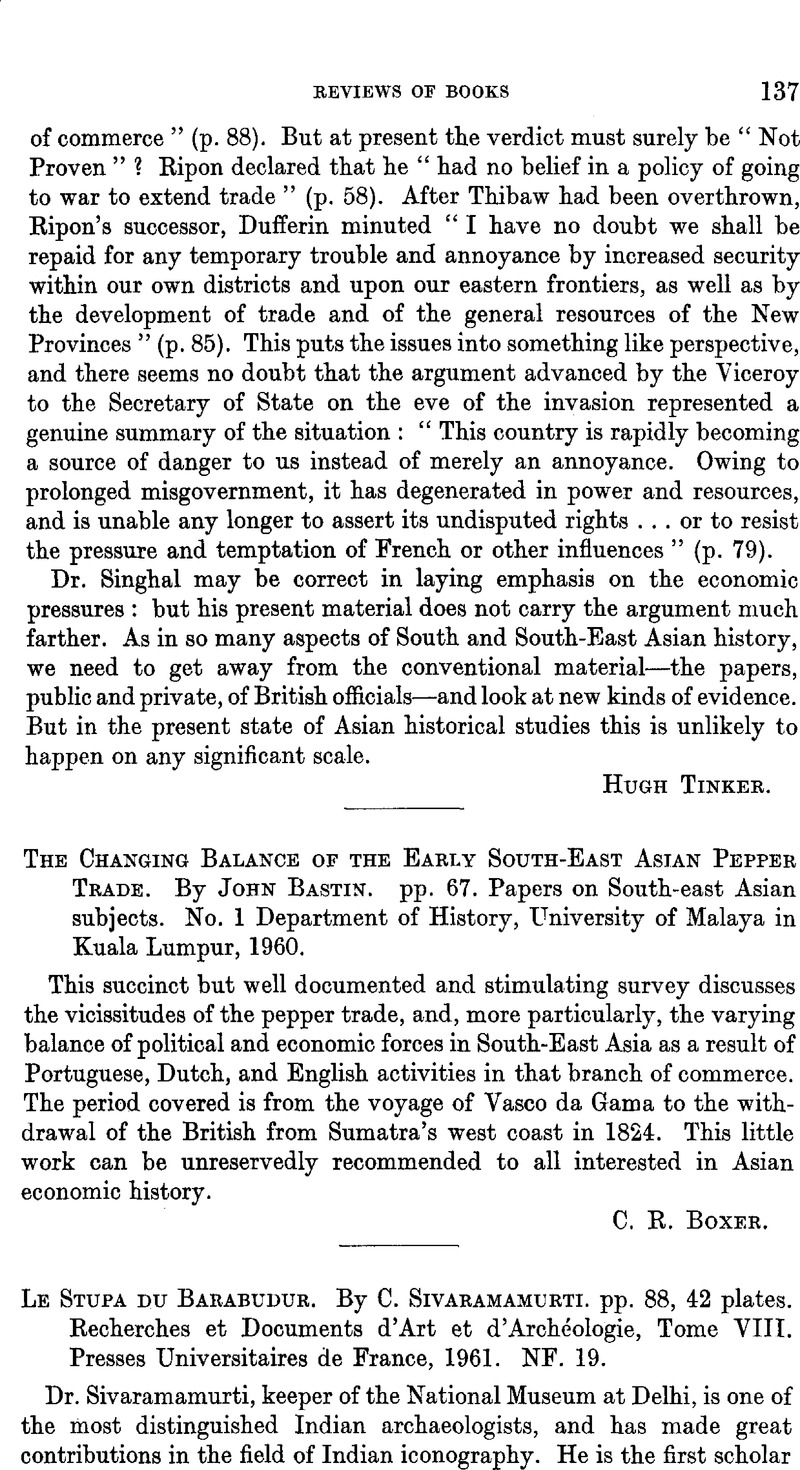No CrossRef data available.
Published online by Cambridge University Press: 15 March 2011

page 138 note 1 Stutterheim, W. F., Tjandi Baraboedoer, Naam, Vorm en Betekenis, 1929Google Scholar.
page 138 note 2 Mus, Paul, Barabuḍur; esquisse d'une histoire du bouddhisme, fondé sur la critique archéologique des textes, with a preface by Coedès, G., 1935Google Scholar.
page 138 note 3 Lévi, Sylvain, Le Māharmavibhaṅga et Karmavibhangopadeśa, 1932Google Scholar.
page 138 note 4 The late Ir. J. L. Moens, in his long article on Barabudur, Mendut, and Pawon, explained the name Barabuḍur as Bhārabuddha-ūr (Tijdschr. Kon. Bat. Gen., lxxxiv (1951), pp. 326–433Google Scholar). He explained Bhārabuddha as a dynastic name of the Śailendras formed in imitation of the Bhāraśivas, a relatively obscure Nāga dynasty of Padmāvatī, mentioned in the Chammak inscription of the Vākākāṭaka Pravarasena II (Sircar, D. C., Select Inscriptions, p. 420, line 7Google Scholar). Cf. Trivedi, H. V., Catalogue of the coins of the Nāga kings of Padmāvatī, 1957, p. IIGoogle Scholar. Moens got his information from Jayaswal's History of India, in which the importance of the Nāgas of Padmāvatī is greatly exaggerated.
page 138 note 6 This may seem curious but, as far as I know, not one Tamil word has been identified in Old Javanese. This is in sharp contrast to the thousands of Sanskrit words. It is true that Malaiyūr occurs in the Tanjore inscription of Rājendracōla I but this is in a Tamil document. The Indonesian form is always Malayu. Malaiyūr is a popular etymology (Tam. malai, “hill” + ūr, “town”; cf. Coedès, , B.E.P.E.O., xviii, 1918, note 2 to p. 6Google Scholar). There are a number of Tamil words in Malay, introduced probably in the fifteenth century.
page 139 note 1 The basic points are given by Poussin, De la Vallće, L'Inde aux temps des Mauryas, etc., 1930, p. 143Google Scholar.
page 139 note 2 These problems are dealt with most authoritatively by Paul Mus, op. cit. Stutterheim, op. cit., defined the monument as a stūpa-prāsāda; in a later article, however, he preferred to interpret it as a huge maṇḍala (“Is Tjandi Baraboedoer een maṇḍala?” Djåwå, xiii, 1933, pp. 233–7Google Scholar). The latter interpretation is based upon the fourteenth century chronicle Nāgarakṛtāgama, in which Buḍur (possibly to be identified with the Barabuḍur) is given in a list of sanctuaries belonging to the Vajradhārin sect of Buddhism. The present reviewer called attention to an inscription dated a.d. 842 in which a foundation undoubtedly to be identified with Barabuḍur is called a kamūlān. This term, a derivative of Sanskrit mūla, appears to be used in Old Javanese inscriptions for sanctuaries essentially devoted to ancestor worship, though usually in the form of a Hindu temple or a Buddhist stūpa. (Prasati Indonesia, I, 1950, pp. 170–5Google Scholar). This is not as strange as it may seem, since the stupa itself may originally have been a funerary monument (Przyluski, J., “Les Funérailles du Bouddha”, Journ. Asiat., 1918–1920, pp. 1–216Google Scholar; De la Vallée Poussin, op. cit., p. 143; Combaz, Gisbert, L'évolution du stūpa en Asie, 1937)Google Scholar.
page 139 note 3 But here again the basic study on the subject (Jaap Kunst, in collaboration with Goris, R., Hindoe-Javaansche Muziekinstrumenten, 1927Google Scholar) is ignored.